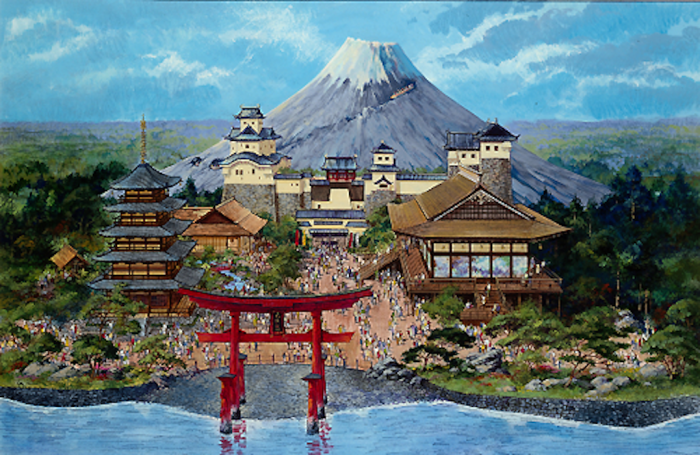How Photography Stopped Disney’s Rollercoaster In Its Tracks

On October 1, 1982, Walt Disney World expanded dramatically. The theme park, which previously consisted primarily of the Magic Kingdom, opened the doors to EPCOT. This second theme park, perhaps best known for the massive golfball-shaped ride known as “Spaceship Earth,” had a futuristic theme through many of its attractions, but it also contained a World’s Fair-style experience known as the World Showcase. Nine different nations (at the time; now there are 11) are represented with rides, restaurants, shops, and other exhibits with a thematic tie-in. The Mexican pavilion has a Mesoamerican pyramid, while the French one has a mini Eiffel Tower, for example.
And the Japanese one? It has a pagoda and some other cool attractions, sure. But what it doesn’t have is a rollercoaster — even though it was probably supposed to.
Pictured above is concept art for the Japan pavilion via the Disney fan site All Ears. In the foreground is a replica of the Itsukushima Shrine, which you’ll see if you visit the pavilion today. (The original is near Hiroshima.) There’s a pagoda or two, as expected. And then there’s a mountain, which is supposed to represent Mount Fuji, a famous active volcano. And the mountain would have been more than just eye candy for EPCOT. The World Pavillion isn’t known for its thrill rides — hardly — and the designers believed that Mount Fuji could have changed that. It was the perfect place for an indoor rollercoaster.
But if you visit the Japan pavilion today, there is no rollercoaster. And, in fact, there’s no Mount Fuji at all. The problem? Money, at first, but that was only part of the issue. Almost everything at EPCOT cost a pretty penny, and Disney had a tried-and-true way of handling those costs: naming rights. Mickey et al often found commercial sponsors to help fund a project, with the sponsor getting a bunch of adverting here, there, and everywhere throughout the experience. For example, telecom company Bell System originally sponsored Spaceship Earth, Exxon sponsored a pavilion about the future of energy, and Kraft sponsored one called “The Land” that focused on agriculture and food technology. If Disney was going to build a fake Mount Fuji, they needed to find a backer.
The obvious choice was Fujifilm, a leading maker of film (obviously) at the time — but there was a problem. On the other side of EPCOT was the “Journey into Imagination,” an attraction featuring a ride exploring the benefits of thinking outside the box, all leading to a bunch of hands-on activities for kids (and adults, I guess) that were designed to spark creative play. The sponsor of that experience? Kodak — Fujifilm’s largest competitor at the time. And that wasn’t the only thing Kodak funded; the camera giant’s sponsorship deal also called for “Kodak Picture Spots, like the one seen here, throughout the Magic Kingdom and EPCOT. Disney could not take any funding from Fujifilm without risking the Kodak relationship.
What happened next is unclear. Reports vary — some sources say Disney declined to build the mountain to avoid a conflict with Kodak, while others suggest Kodak vociferously objected to having a mountain named after its competitor. But either way, if you visit the Japan pavilion today, there’s no Mount Fuji, because of Kodak.
Bonus fact: In the 1960s, Walt Disney (the person, not the company) piloted the plans for a futuristic company city — but Disney’s dream town never got built. Those dreams, though, inspired EPCOT, which is why EPCOT is stylized in all capital letters. The theme park’s name is an acronym — it stands for “Experimental Prototype Community of Tomorrow.”
From the Archives: Nuclear Photographs: When Kodak built itself a nuclear reactor.
